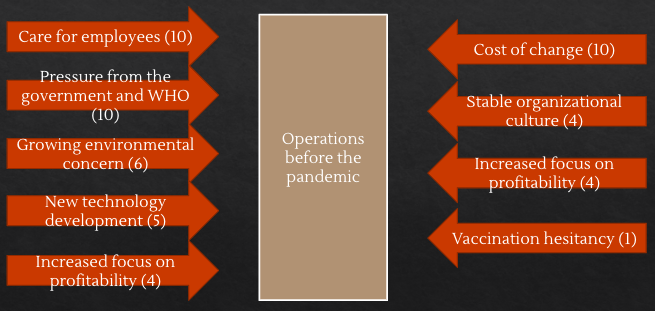Introduction and Purpose Statement
In this paper, we are going to discuss the importance of change management using the example of Qatargas, which was forced to implement significant changes due to the COVID-19 pandemic.
In order to achieve this purpose, several objectives were outlined. They include:
- Conceptualize change management;
- Describe the change in Qatargas;
- Overview of the company background;
- Analyze change in Qatargas against change theories;
- Outline critical success factors of change.
Key Concepts
The key concepts of this presentation are organizational change and change management. Harvard business school defines organizational change as actions in which a company or business alters a major component of its organization, such as its culture, the underlying technologies or infrastructure it uses to operate, or its internal processes. In other words, the definition demonstrates that when we are speaking of an organizational change, we are speaking of a major change in the way a company operates.
Harvard Business School defines change management as a “method of leveraging change to bring about a successful resolution.” In other words, change management is a structured process meant to help a company achieve a desired outcome. It can be understood as a set of tools that are designed to facilitate the transition from the current state to the desired state in different aspects of the business.
Types of Change
There are several types of changes. First, organizational change can be either managed or unmanaged. Managed change is an organizational change that has a clear purpose and implementation plan carried out by a designated manager. Unmanaged changes are spontaneous without a clearly established purpose or plan that happens as a reaction to alterations in the external or internal environment. The results of unmanaged change are always unpredictable, which implies that managed organizational change is preferred.
Managed change can be either adaptive or transformational. When we are talking about an adaptive change, we mean a small-scale change required to fine-tune business operations. Transformational change is a laborious endeavor that may affect mission and strategy, company or team structure, people and organizational performance, or business processes. Transformational changes are significant alterations in the company’s operations to achieve better performance.
The change in Qatargas operations associated with the pandemic is a managed transformational change, as it affected all the aspects of the operations activities.
Brief Description of Change
Now we will turn to the case itself. On March 11, 2020, the World Health Organization officially declared COVID-19 a pandemic. Qatargas activated a ‘Tier 3’ Crisis Management Team, ultimately resulting in the creation of the Qatargas COVID-19 Taskforce. The task force adopted a risk-based strategy for Qatargas, which is aligned with the Qatar government and QatarEnergy regulations. In particular, the Qatargas COVID-19 task force developed a robust approach for the identification, evaluation, mitigation, and action tracking of risks. This approach was meant to provide the Qatargas Management Leadership Team and shareholders visibility and assurance that the most critical risks faced by the company were being adequately addressed and mitigated.
The plan was implemented effectively, which allowed the company to achieve its goals, which included the safety of employees and the community, stability of business operations, minimal impact on financial performance, and low concern of shareholders.
Change Plan Details
The change plan consisted of several aspects. First, the company ensured the continuity of its business through the development of the containment and isolation model provided in this slide. The model included a series of prevention, mitigation, response, and recovery activities. Second, the company engaged with stakeholders to communicate the efforts of the company concerning the pandemic. Third, Qatargas supported the communities by establishing a vaccination campaign and developing a testing facility. Fourth, Qatargas established a work-from-home policy to take care of the health and safety of the employees. Fifth, the company launched a long-term environmental strategy. Finally, Qatargas digitalized all the corporate training sessions to protect its employees from possible contamination.
Company Background
Qatargas is a unique global energy operator in terms of size, service, and reliability. Since 1984, Qatargas has been developing, producing, and marketing hydrocarbons from the world’s largest non-associated natural gas field.
The company’s vision is to be the world’s premier LNG company.
Qatargas describes its mission in aspects. First, Qatargas aims to provide quality LNG and other hydrocarbon products to the global market. Additionally, Qatargas protects its people, assets, and environment.
The company outlines six central values. They include:
- Safety, health, and environment.
- High-caliber workforce.
- Efficient and reliable operations.
- Quality and flawless execution.
- Customer satisfaction.
- Financial performance.
Environmental Analysis
In 2020, Qatargas operated in a quickly-changing external environment. PEST analysis was conducted to assess political, economic, social, and technological factors that affected Qatargas. The political factors included the growing push of international organizations and governments for environmental sustainability, the Qatar diplomatic crises of 2017 that continued to affect Qatar’s relationships with its neighboring countries and recommendations of the World Health Organization concerning the reaction to the pandemic.
The economic factors included low prices of liquidized natural gas in 2020 and the global economic crisis due to the pandemic. However, it should be noted that Qatar’s performance in terms of GDP in 2020 was among the strongest in the world.
The social factors included increased concern about the pandemic and vaccination hesitancy at the same time. Additionally, the growing awareness of environmental problems had a significant impact on the company.
Finally, the technological factors that affected the change strategy were the quick development of vaccines and testing systems and distant work software development.
Internal Analysis
The internal analysis revealed several factors that affected the change process. Qatargas views employees as the key resource of the company. As a result, the company has increased concern about employee health, safety, and development. A clear company structure allowed the executive team to react quickly to the situation, which minimized the impact on the flow of the operation. The focus on financial performance motivated the company leaders to optimize the work process to decrease the impact on the company’s profitability. However, the stability of the workplace culture negatively affected the change process, as employees were emotionally attached to the old ways.
Lewin’s Force Field Model
In order to understand the motivation behind the change, it is beneficial to use Lewin’s force field model. According to this model, the present state exists due to the equilibrium in driving and restraining forces. However, as soon as the balance is distorted, change begins.
The use of Lewin’s model can help to distribute the internal and external factors between driving and restraining forces.

Application of Lewin’s Force Field Analysis
Lewin’s force field analysis is provided above. The results revealed that the driving forces depicted on the left were stronger than the restraining forces depicted on the right. As a result, the COVID-related changes to the operations were implemented. It is crucial no note that increased focus on profitability is demonstrated as both a restraining and a driving force. The reason for that can be explained in the following way. On the one hand, the company does not want to implement change as it is associated with significant costs, which affects profitability. On the other hand, profitability can be affected due to the harm to the employees affected by the pandemic. Thus, the company is interested in implementing the changes as fast as possible to prevent losses associated with human resource use inefficiency.

Lewin’s Change Model
The success of change can be explained by the fact that it was implemented in accordance with Lewin’s theory of planned change. According to the model, all changes go through three stages, including unfreezing, change, and refreezing. During the first stage, Qatargas formed the COVID-19 task force, assessed the situation, and disseminated knowledge received from the results of the assessment. The analysis of operations revealed that it was inadequate considering the new threats associated with the pandemic.
During the second stage, the company developed a clear response plan that was introduced earlier in the presentation and implemented this plan.
Finally, as the plan was implemented, the task force conducted an audit of current operations and made small enhancements to the process. After that, new norms were established through policies, such as the new communication policy, decontamination policy, and health policy. Finally, training was provided to ensure that personnel adhered to new norms.
Change Outcomes
The change resulted in success. Some of the outcomes included the following:
- First, the company was among the first to react to the pandemic, which allowed it to minimize the harm to the health and safety of the employees. Second, the company adhered to all the recommendations provided by the government and the world health organization, which resulted in the approval of the new policies from the regulating authorities. Third, the employees were highly satisfied with the change, as the company took care of all the needs of the employees. Finally, the company’s image was improved significantly in the eyes of investors and customers for various reasons. One of the reasons was the fact that the company adhered to its strive for environmental sustainability regardless of the influence of the pandemic.
Key Success Factors
The key success factors that led to the success of the change were the following. First, the company had a clear workplace culture that allowed it to form a response plan in accordance with its values, mission, and vision. Second, the change was carefully planned with clearly defined goals and objectives, which allowed for effective implementation. Third, change was led by the most talented and experienced leaders, which resulted in increased trust and respect among employees. Finally, change was well communicated through all the possible channels, which minimized resistance and maximized trust among stakeholders.
Conclusion
In conclusion, change management was found to be of crucial importance in controlling the outcomes of change. The analysis revealed that the utilization of change management theories and techniques had a significant contribution to change outcomes. The process of adaptation of Qatargas to operations during the pandemic is an excellent example of change management.
Sources
Connelly, M. (2020) Force Field Analysis – Kurt Lewin. Web.
Harrington, H. J. and Voehl, F. (2017) Change Management: Manage the Change or It Will Manage You. United States: Taylor & Francis.
Qatargas (2021) Sustainability report. Web.
Lewin, K. (2013). The conceptual representation and the measurement of psychological forces. Eastford: Martino Fine Books.
Recardo, R. J. and Jones, D. J. (2013) Leading and Implementing Business Change Management: Making Change Stick in the Contemporary Organization. United Kingdom: Taylor & Francis.
Stobierski, T. (2020) Organizational change management: What it is & why it’s important. Web.